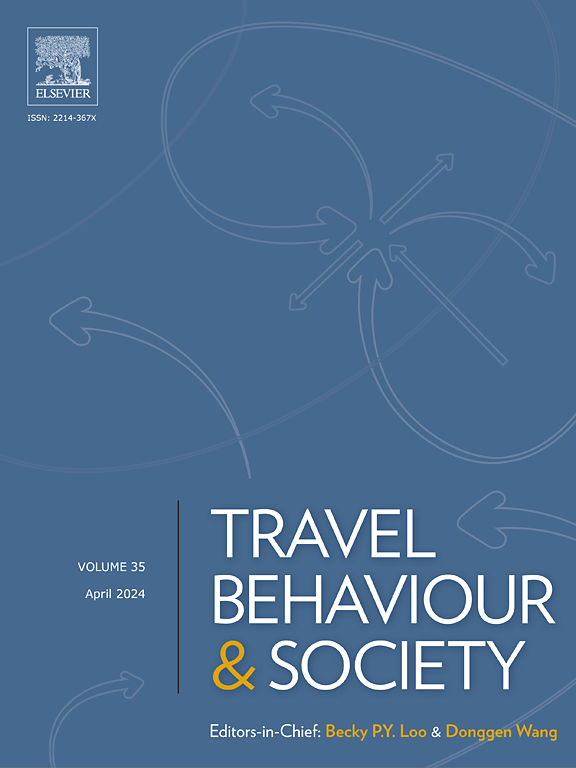Shared e-bikes demand in urban mobility: Temporal heterogeneity, driving factors, and strategic implications
IF 5.7
2区 工程技术
Q1 TRANSPORTATION
引用次数: 0
Abstract
Electric bicycles (e-bikes) are recognised as a sustainable solution for urban travel, addressing increasing travel demand while reducing emissions. Shared e-bikes, with increasingly developed infrastructure and integration with existing urban transportation systems, offer an efficient alternative, especially in short-distance travel. Understanding the variation in shared e-bike usage and its interaction with external factors is important for optimising system performance. Using shared e-bike transaction data from Nanning, this study employs traditional statistical regression (Spatial Lag Model, SLM) and machine learning (Extreme Gradient Boosting, XGBoost) to reveal demand variations across seven distinct time segments. SLMs identify the significance and coefficient variations of explanatory variables, while XGBoost reveals shifts in feature rankings and influence thresholds. Findings from both models highlight the significant influence of public transit and certain facilities on shared e-bike demand, with notable temporal patterns. Results indicate shared e-bikes’ role in facilitating users’ weekday routines, particularly commuting, and supporting leisure activities around areas populated with restaurants and universities during after-work hours. Shared e-bikes also show a positive trend of integration with current transit systems. These findings suggest a deployment focus that varies by time: balancing shared e-bikes around transit stations, residential areas, and office buildings during weekday peak hours, and around restaurant-populated areas and transit stations as the day unfolds; during weekends, prioritising transit stations, universities, densely populated areas, and restaurants. With guided attention to different time slots, the findings will help operators optimise resources and enhance service outcomes.
城市交通中的共享电动自行车需求:时间异质性、驱动因素和战略意义
电动自行车被认为是城市出行的可持续解决方案,在满足日益增长的出行需求的同时减少了排放。随着基础设施的日益发达以及与现有城市交通系统的融合,共享电动自行车提供了一种高效的选择,尤其是在短途旅行中。了解共享电动自行车使用的变化及其与外部因素的相互作用对于优化系统性能非常重要。本研究利用南宁市共享电动自行车交易数据,采用传统的统计回归(空间滞后模型,SLM)和机器学习(极限梯度提升,XGBoost)来揭示七个不同时间段的需求变化。slm识别解释变量的显著性和系数变化,而XGBoost揭示特征排名和影响阈值的变化。两个模型的结果都强调了公共交通和某些设施对共享电动自行车需求的显著影响,并且具有显著的时间模式。结果表明,共享电动自行车在方便用户的日常工作,特别是通勤方面的作用,并支持下班后在餐馆和大学密集地区的休闲活动。共享电动自行车也呈现出与现有交通系统融合的积极趋势。这些发现表明,部署的重点随时间而变化:在工作日的高峰时间,在公交车站、居民区和办公楼周围,以及在餐馆人口密集的地区和公交车站周围,平衡共享电动自行车;在周末,优先考虑交通车站、大学、人口稠密地区和餐馆。通过对不同时段的引导关注,研究结果将帮助运营商优化资源并提高服务效果。
本文章由计算机程序翻译,如有差异,请以英文原文为准。
求助全文
约1分钟内获得全文
求助全文
来源期刊

Travel Behaviour and Society
TRANSPORTATION-
CiteScore
9.80
自引率
7.70%
发文量
109
期刊介绍:
Travel Behaviour and Society is an interdisciplinary journal publishing high-quality original papers which report leading edge research in theories, methodologies and applications concerning transportation issues and challenges which involve the social and spatial dimensions. In particular, it provides a discussion forum for major research in travel behaviour, transportation infrastructure, transportation and environmental issues, mobility and social sustainability, transportation geographic information systems (TGIS), transportation and quality of life, transportation data collection and analysis, etc.
 求助内容:
求助内容: 应助结果提醒方式:
应助结果提醒方式:


